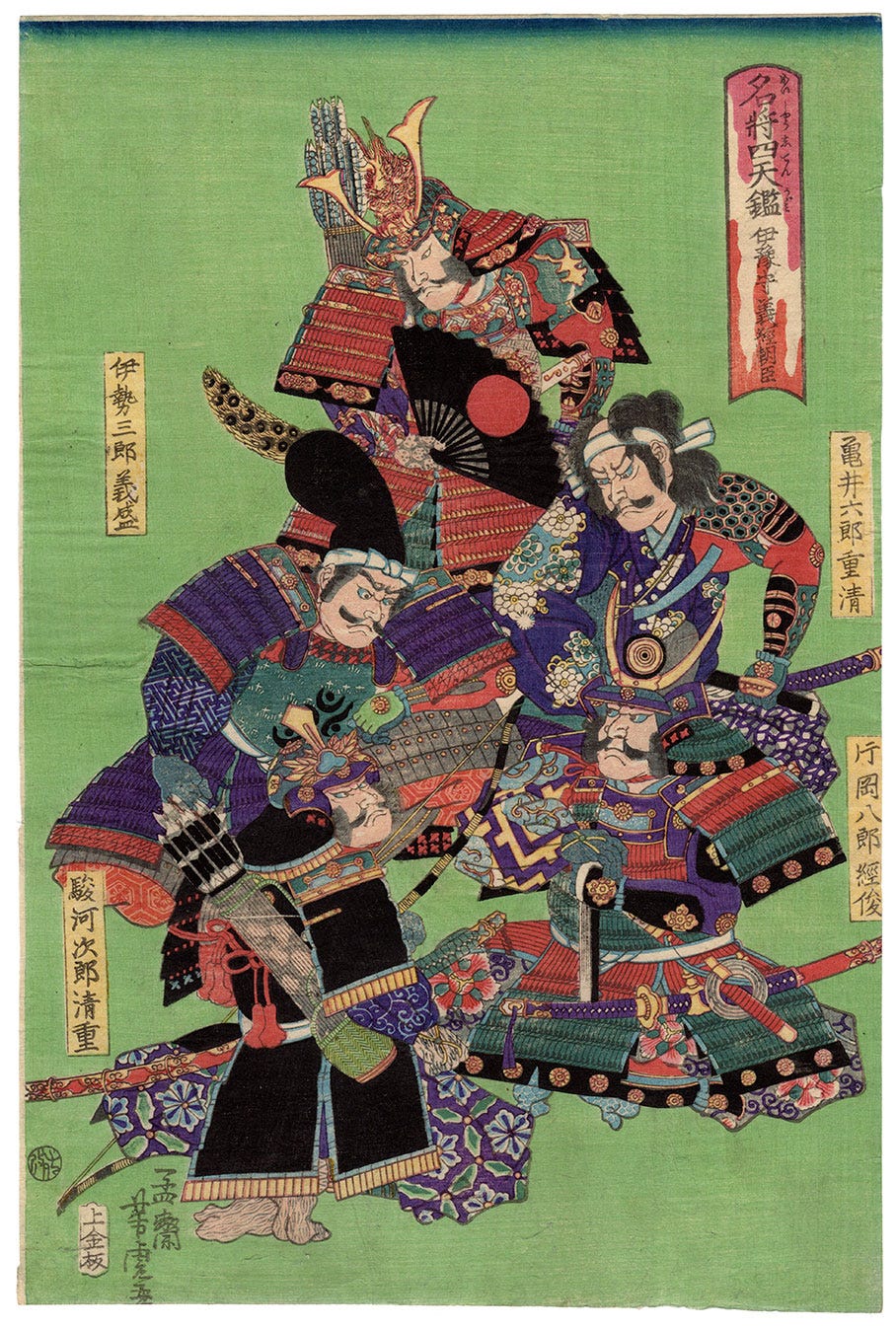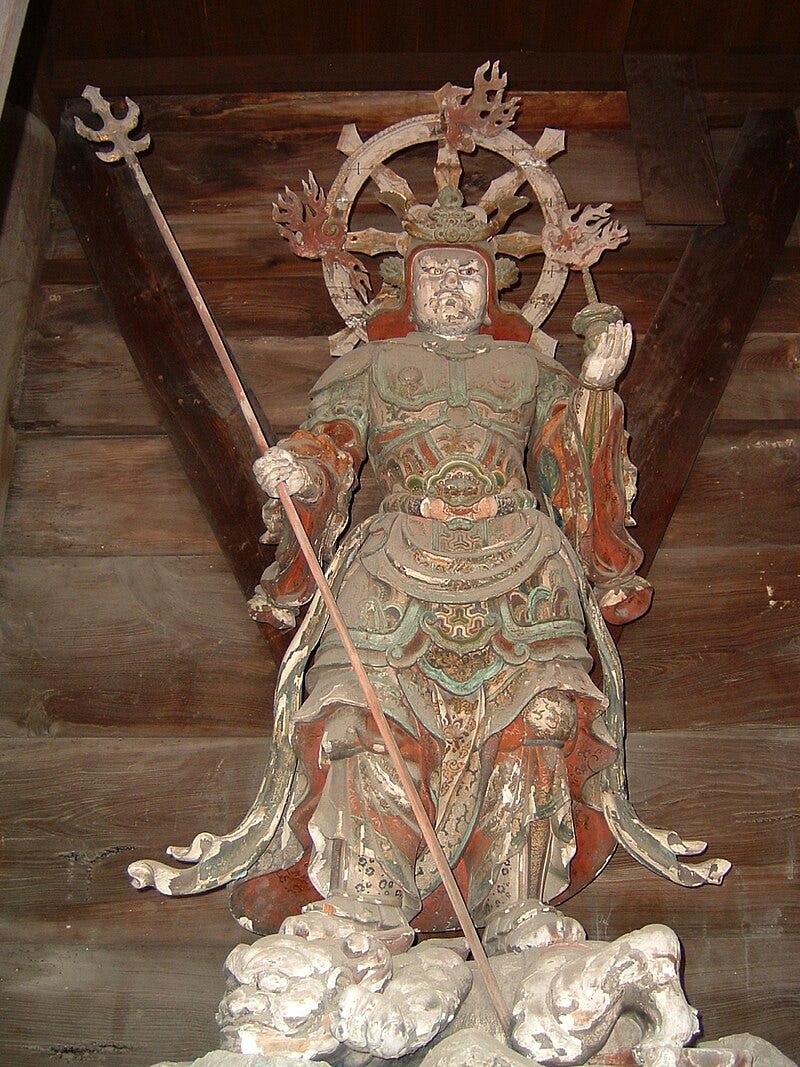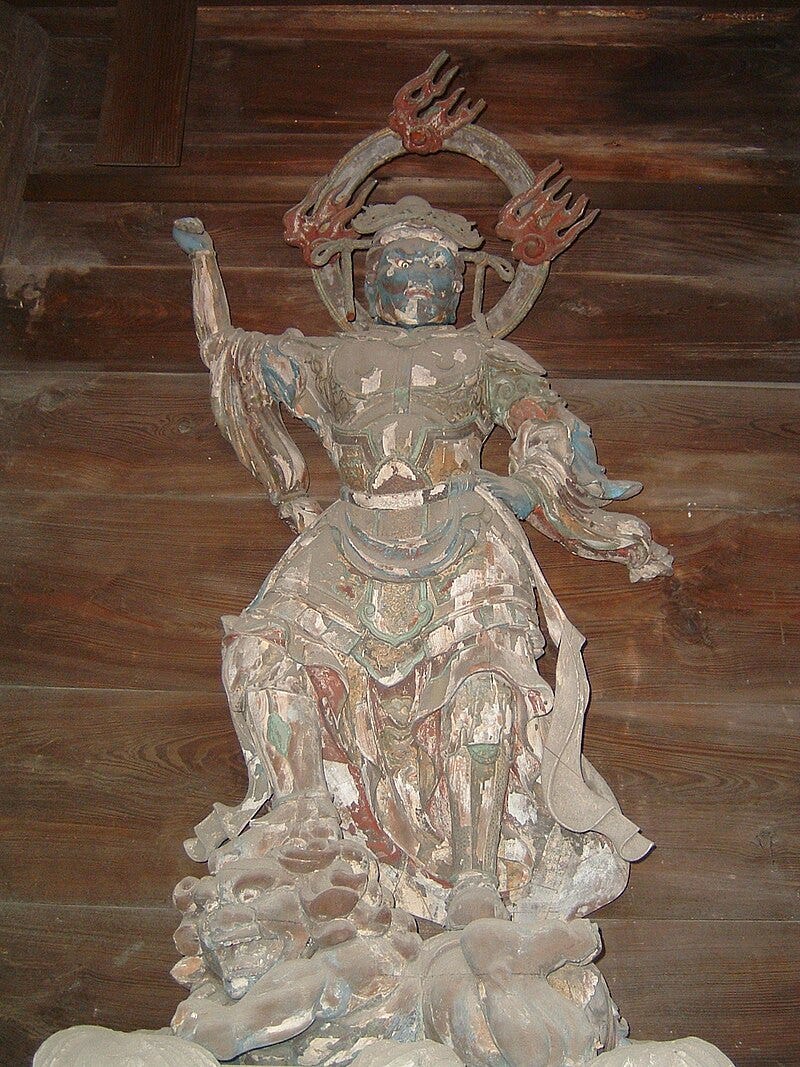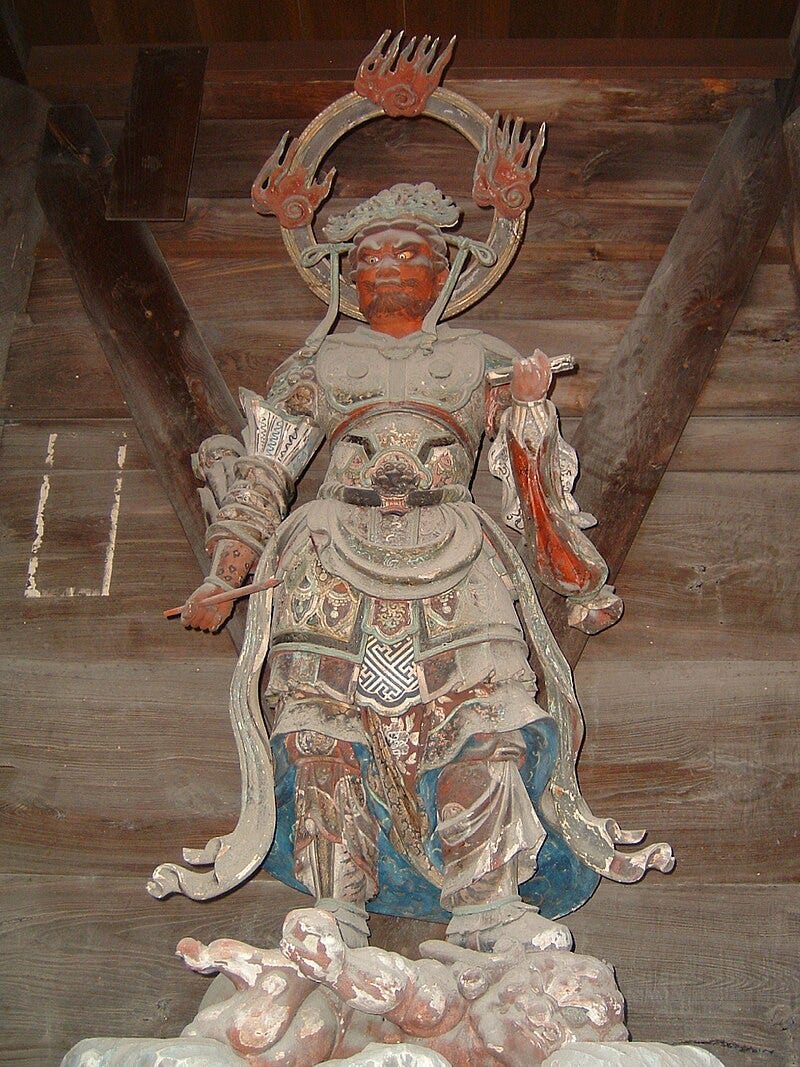四天王 Shitennō: The Four Heavenly Kings
History, philosophy, and influence on the japanese warrior class
The Four Heavenly Kings, known in Japan as Shitennō (四天王), are protective deities in Buddhism, each assigned to guard one of the four cardinal directions and defend the Dharma (Buddhist teachings) against evil forces. Introduced to Japan via China and Korea, the Shitennō became central figures of devotion in Japanese Buddhism, especially during the Nara (710-794) and Heian (794-1185) periods. Over time, their image as guardians and protectors gained significance among Japanese warriors, who looked to the Shitennō as a source of inspiration and protection in battle.
History and origin of the Shitennō
The Four Heavenly Kings originated in ancient Indian cosmology and were incorporated into Buddhism as the Chaturmahārāja (Four Great Kings). In Buddhist tradition, these celestial kings reside on Mount Sumeru, a mythical mountain that occupies the center of the universe in Indian and Buddhist cosmology. Their primary function is to protect the world and the teachings of the Buddha from malignant forces, serving as guardians of the Dharma.
As Buddhism spread eastward, the Four Heavenly Kings were assimilated into the cultures of China and Korea, gaining new iconographic and symbolic features. In China, they became known as Sì Dà Tiānwáng (四大天王), depicted in armor and wielding weapons, emphasizing their military role as protectors. When Buddhism arrived in Japan, the Shitennō were adopted by Japanese nobility and temples, establishing an iconography that persists to this day.
The Four Heavenly Kings: Names and attributes
Each of the Four Heavenly Kings represents a cardinal direction and has specific roles and attributes:
Tamonten (多聞天) - King of the North
Sanskrit: Vaiśravaṇa
Role: Protector of wealth and guardian of the North.
Attributes: Often depicted holding a pagoda (symbolizing Buddhist teachings) and a staff or spear.
Symbolism: Represents generosity, power, and the safeguarding of spiritual and material wealth.
Zōchōten (増長天) - King of the South
Sanskrit: Virūḍhaka
Role: Protector of the South and the spread of Buddhist teachings.
Attributes: Carries a sword, symbolizing the strength and resolve to defend the Dharma.
Symbolism: Embodies growth and the protection of Buddhism.
Jikokuten (持国天) - King of the East
Sanskrit: Dhṛtarāṣṭra
Role: Guardian of the East and protector of divine music and the arts.
Attributes: Often holds a lute or sword, representing harmony and cultural preservation.
Symbolism: Represents vigilance and the preservation of spiritual harmony.
Kōmokuten (広目天) - King of the West
Sanskrit: Virūpākṣa
Role: Protector of the West with omniscient vision.
Attributes: Holds a snake or a banner, symbolizing his ability to see and understand all events.
Symbolism: Embodies wisdom and knowledge, essential for protecting the Dharma.
Philosophy of the Shitennō and their role in japanese Buddhism
The philosophy of the Shitennō centers on the protection of the Dharma and the defense of justice. Each of the kings symbolizes a virtue essential for maintaining spiritual and social order: generosity, growth, vigilance, and wisdom. These virtues are central in esoteric Buddhism, where the Shitennō serve not only as physical protectors of temples and monks but also as guardians of Buddhist ideals.
In Japan, the Shitennō acquired additional symbolic significance as they were incorporated into temple art and architecture. For instance, at Hōryū-ji Temple in Nara, one of Japan’s oldest temples, iconic representations of the Shitennō are displayed in armor, each positioned in a cardinal direction within the main pagoda. Their presence in temples was not merely decorative; it was a spiritual defense against negative forces and a visual reminder of the vigilance needed to uphold the Buddhist path.
Influence of the Shitennō on the japanese warrior class
As Buddhism spread in Japan, the image of the Shitennō was adopted by the samurai and warrior class, who saw these celestial kings as models of strength and protection. The Shitennō offered warriors an ideal of justice and power directed not toward personal gain but toward protecting order and moral duty.
One famous samurai who venerated the Shitennō was Uesugi Kenshin (1530-1578), who considered Tamonten (Bishamonten) to be his personal protector. Kenshin conducted rituals before battles, invoking the protection of Bishamonten and the other Shitennō. He believed these celestial kings granted him the strength and clarity to defend his territory with integrity and loyalty, ideals reflected in the code of bushidō.
For samurai, veneration of the Shitennō meant that battle was not only a physical act but also a spiritual responsibility. It was about defending order and protecting the vulnerable, in accordance with the virtues of the Four Heavenly Kings. Some clans even established altars to the Shitennō in their castles and homes, seeking their protection and blessing in warfare.

The term Shitennō (四天王), also applies to the most loyal protectors of certain of Japan's most famous legendary and historical figures. For example, Minamoto no Yoshitsune (1159-1189) was accompanied by the four loyal great warriors known as the Shitennō of Yoshitsune:
Suruga Jirō Kiyoshige (駿河次郎清重)
Kamei Rokurō Shigekiyô (亀井六郎重清)
Kataoka Hachirō Tsuneharu (片岡八郎常春)
Ise Saburō Yoshimori (伊勢三郎義盛)
Rituals and prayers to the Shitennō
Rituals dedicated to the Shitennō vary by temple and tradition but often include offerings, chanting, and specific meditative practices. Some of the most common practices include:
Offerings and altar prayers
In temples, statues of the Shitennō are placed in the four corners of main halls or pagodas, and devotees offer rice, incense, and sake. Prayers typically request protection, wisdom, and strength to face difficulties.
Mantras and Dharanis
Each of the Shitennō has specific mantras and dharanis (longer incantations) used to invoke their protection. A popular mantra for Bishamonten (Tamonten) is: “On Beishiramandaya Sowaka” (オン・ベイシラマンダヤ・ソワカ)
This mantra is recited repetitively during meditation to attract the protection and strength of the Shitennō.
Festivals and temple ceremonies
Certain temples, such as Hōryū-ji and Shitennō-ji in Osaka, hold annual festivals in honor of the Shitennō. During these events, monks conduct specific rituals, such as processions and chanting, to strengthen the spiritual protection of the community.
The Shitennō in modern Japan
Although the samurai era has ended, the figure of the Shitennō remains relevant in Japan. Their image persists in temples and popular culture as symbols of protection, justice, and strength. In martial arts, practitioners see the Shitennō as examples of dedication and spiritual discipline, applying the same principles of vigilance and justice in their training.
Moreover, the Shitennō are still revered in Japanese temples and shrines, and some modern martial arts leaders, such as those in kendo and aikido, hold ceremonies in their honor. The Shitennō continue to represent an ideal of spiritual warriorhood—a balanced force that upholds order and seeks justice.
The Four Heavenly Kings, or Shitennō, represent a key figure in Japanese spirituality and culture. Their role as guardians of the Dharma and defenders of justice has shaped the ideals of Japanese warriors and continues to resonate as a symbol of vigilance and strength. As protectors of temples and patrons of righteousness, the Shitennō embody a balance between might and virtue—an ideal that has profoundly influenced the warrior philosophy of Japan and endures in the spirit of modern martial arts and spiritual practices.








